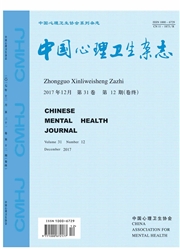

 中文摘要:
中文摘要:
目的:探讨抑郁症患者的神经软体征的行为学特征。方法:以68例符合美国精神障碍诊断与统计手册第4版(DSM—IV)诊断标准的门诊或住院抑郁症患者及68名健康对照为研究对象,采用剑桥神经科检查(CNI)软体征测试分量表,从运动协调、感觉整合、抑制功能三方面对两组对象进行神经软体征的行为学测查。并使用汉密顿抑郁量表(HAMD)评估抑郁症患者的病情严重程度。本调查中所有患者均处于抑郁缓解期,且均正在接受抗抑郁药物的治疗。结果:抑郁症组的HAMD平均得分为(18.2±7.8)。抑郁症组与对照组的神经软体征测试总分[(3.2±2.8)VS.(3.5±2.6)]、运动协调分[(0.9±1.3)VS.(1.2±1.6)]、感觉整合分[(1.5±1.5)VS.(1.3±1.0)]、抑制功能分[(0.8±0.9)VS.(0.9±1.0)]差异均无统计学意义(均P〉0.05)。结论:本研究显示处于抑郁缓解期并接受抗抑郁药物治疗的抑郁症患者与健康对照的神经软体征整体表现基本一致。
 英文摘要:
英文摘要:
Objective: To compare the prevalent rates of neurological soft signs (NSS) in patients with de- pression with those of normals. Methods: Sixty-eight in-and outpatients with depression and 68 demographically matched healthy controls took part in the study. All patients were diagnosed by experienced psychiatrists according to the Diagnostic and Statistical Manual of Mental Disorders-IV, Fourth Edition (DSM-IV) criteria, and the severity of their depression was assessed with the Hamilton Depression Scale (HAMD). In addition, all patients were in the remission stage and were receiving anti-depression treatment. The NSS subscales (motor coordination, sensory inte- gration, and disinhibition) of the Cambridge Neurological Inventory (CNI) were administered to all patients and healthy controls. Results: The mean score of HAMD in patients was ( 18.2 ± 7. 8). No significant group differences were found for the total score of NSS [ (3.2 ± 2. 8) vs. (3.5 ± 2. 6) ] and the subscale scores of motor coordination [ (0. 9 ± 1.3) vs. ( 1.2 ± 1.6) ], sensory integration [ ( 1.5 ± 1.5) vs. ( 1.3 ± 1.0)] and disinhibition [ (0. 8 ± 0. 9) vs. (0. 9 ±1.0)]. Conclusion: It suggests that the prevalent rates of neurological soft signs in patients with remis- sion depression and healthy controls may be similar.
 同期刊论文项目
同期刊论文项目
 同项目期刊论文
同项目期刊论文
 期刊信息
期刊信息
